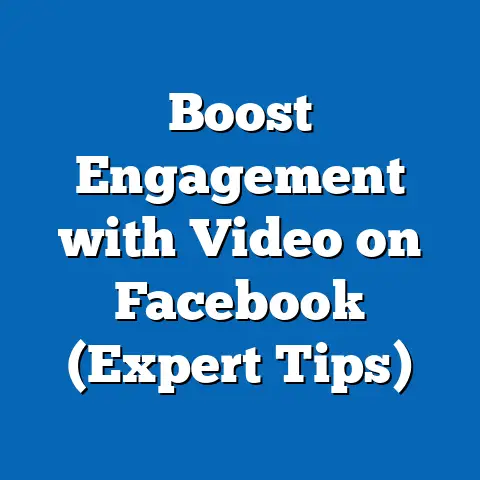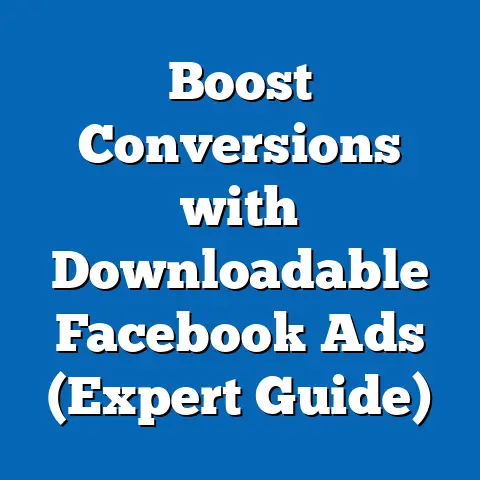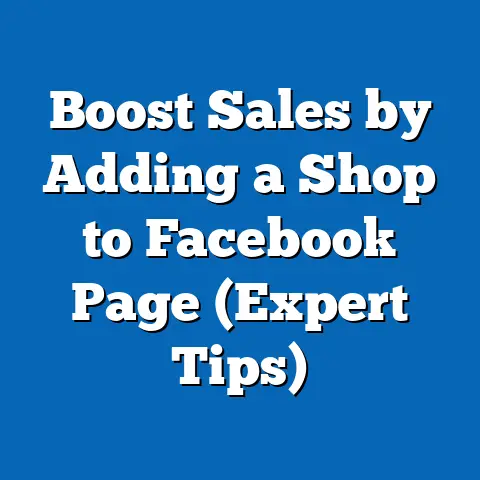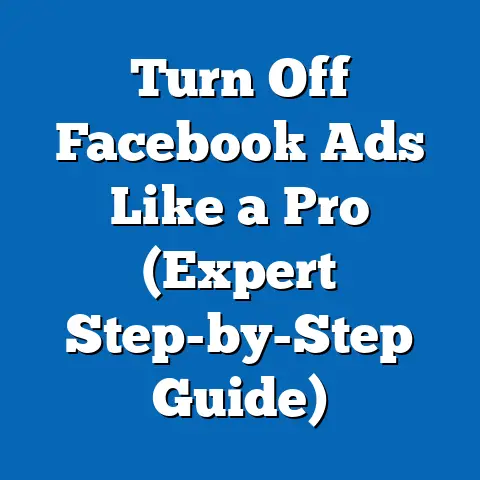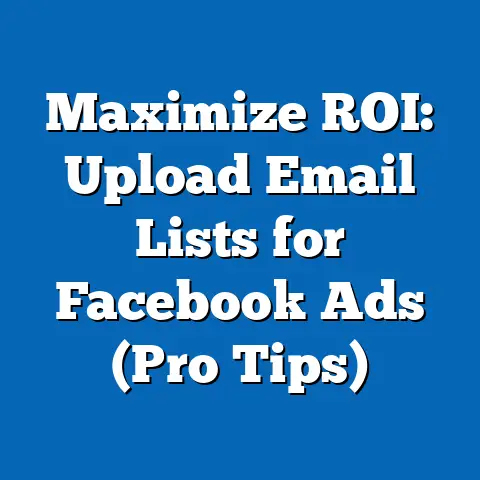Revive Disabled fb ad Account (Proven Recovery Strategies)
Do you remember those early days of Facebook advertising? It felt like the Wild West, didn’t it? I recall the sheer excitement of launching my first campaign, carefully crafting my message, and then… boom! Watching those numbers climb in real-time. It was like having a direct line to my ideal customer. Back then, Facebook felt like an open field, ripe for the picking. I was empowered, my clients were thrilled, and sales? Well, let’s just say they were skyrocketing. It was an entrepreneur’s dream come true.
But times have changed, haven’t they? What was once a relatively straightforward process has become a complex landscape of policies, algorithms, and, yes, account disablements. And let’s be honest, few things are more frustrating than pouring your heart and soul into your Facebook advertising strategy, only to have your ad account suddenly disabled. It’s like the rug’s been pulled out from under you.
That’s why I’m writing this guide. I’ve been there. I’ve felt that gut-wrenching feeling of seeing that dreaded “Account Disabled” message. And I know how much it can impact your business, your marketing strategies, and even your brand reputation. But don’t despair! While it might feel like the end of the world, it’s not. With the right strategies and a little bit of persistence, you can revive your disabled Facebook ad account and get back to connecting with your audience. I’m here to share the proven techniques I’ve learned over the years, so you can navigate this challenging situation and get back to what you do best: growing your business.
Understanding Why Facebook Ad Accounts Get Disabled
Before we dive into the recovery process, it’s crucial to understand why Facebook ad accounts get disabled in the first place. Think of it as understanding the enemy before you engage in battle. Facebook’s primary goal is to provide a safe and positive experience for its users. This means they have strict advertising policies in place, and any violation, intentional or not, can lead to account disablement.
Here’s a breakdown of some of the most common reasons:
- Policy Violations: This is the big one. Facebook has a comprehensive set of advertising policies that cover everything from prohibited content (like hate speech or misleading claims) to restricted content (like alcohol or gambling ads, which require specific permissions). It’s crucial to familiarize yourself with these policies and ensure your ads are compliant.
- Inappropriate Content: Even if your ad doesn’t explicitly violate a policy, it can still be flagged for inappropriate content. This can include ads that are sexually suggestive, excessively violent, or that promote harmful products or services.
- Suspicious Activity: Facebook’s algorithms are constantly monitoring ad accounts for unusual activity. If they detect something suspicious, like a sudden spike in ad spend or ads being run from multiple locations, they may disable your account as a security measure.
- Payment Issues: Problems with your payment method, such as expired cards or insufficient funds, can also lead to account disablement.
- Poor Ad Quality: Facebook prioritizes ads that are relevant and engaging to users. Ads with low-quality images, misleading copy, or poor landing page experiences can be penalized.
- Circumventing Systems: Attempting to bypass Facebook’s advertising systems, such as using cloaking techniques or creating multiple accounts to avoid restrictions, will almost certainly result in account disablement.
The implications of a disabled account are significant. I’ve seen businesses lose thousands of dollars in revenue, have their marketing strategies completely disrupted, and suffer damage to their brand reputation. According to a recent study, approximately 15% of Facebook advertisers experience account disablement at some point. This highlights the importance of understanding the rules of the game and taking proactive steps to avoid violations.
Key Takeaway: Understanding the reasons behind account disablement is the first step towards preventing it. Familiarize yourself with Facebook’s advertising policies, monitor your ad account for suspicious activity, and prioritize ad quality to stay in good standing.
Initial Steps to Take After Your Account is Disabled
Okay, so you’ve received that dreaded notification. Your Facebook ad account is disabled. Take a deep breath. Don’t panic. The first few steps you take are crucial in determining whether you can successfully recover your account.
Here’s what you need to do immediately:
- Review the Notification: The first thing you should do is carefully review the notification you received from Facebook. This notification should provide some insight into why your account was disabled. Look for specific policy violations or reasons cited by Facebook.
- Check Your Email: Facebook often sends a more detailed explanation of the disablement via email. Check the email address associated with your ad account for any messages from Facebook. These emails may contain specific instructions or requests for information.
- Access the Account Quality Dashboard: The Account Quality dashboard is your central hub for understanding the status of your ad account. You can access it by going to Ads Manager and clicking on “Account Quality” in the left-hand menu. This dashboard will provide you with information about any policy violations, account restrictions, and the overall health of your account.
-
Understand Facebook’s Advertising Policies: This is where the real work begins. If you’re not already intimately familiar with Facebook’s advertising policies, now’s the time to get acquainted. These policies are extensive and can be a bit overwhelming, but they are essential for understanding what is and isn’t allowed on the platform.
- Navigating the Policies: Start by reviewing the “Advertising Policies” section of the Facebook Business Help Center. Pay close attention to the categories that are most relevant to your business.
- Focus on Specific Violations: If Facebook has cited a specific policy violation, focus your attention on that particular section of the policies. Read it carefully and try to understand how your ad might have violated it.
-
Gather Documentation and Evidence: To support your case for recovery, you’ll need to gather any relevant documentation and evidence. This might include:
-
Proof of Business Legitimacy: This could include your business license, tax registration, or other official documents that verify your business’s existence.
- Ad Creative and Targeting Information: Collect screenshots of your ads, along with details about your targeting criteria. This will help you demonstrate that your ads were not intended to violate any policies.
- Landing Page Information: Provide information about the landing pages you were directing traffic to, including their content and purpose.
- Any Relevant Communications: If you’ve had any previous communications with Facebook support, gather those records as well.
Understand Facebook’s Advertising Policies: This is where the real work begins. If you’re not already intimately familiar with Facebook’s advertising policies, now’s the time to get acquainted. These policies are extensive and can be a bit overwhelming, but they are essential for understanding what is and isn’t allowed on the platform.
- Navigating the Policies: Start by reviewing the “Advertising Policies” section of the Facebook Business Help Center. Pay close attention to the categories that are most relevant to your business.
- Focus on Specific Violations: If Facebook has cited a specific policy violation, focus your attention on that particular section of the policies. Read it carefully and try to understand how your ad might have violated it.
-
Gather Documentation and Evidence: To support your case for recovery, you’ll need to gather any relevant documentation and evidence. This might include:
-
Proof of Business Legitimacy: This could include your business license, tax registration, or other official documents that verify your business’s existence.
- Ad Creative and Targeting Information: Collect screenshots of your ads, along with details about your targeting criteria. This will help you demonstrate that your ads were not intended to violate any policies.
- Landing Page Information: Provide information about the landing pages you were directing traffic to, including their content and purpose.
- Any Relevant Communications: If you’ve had any previous communications with Facebook support, gather those records as well.
Gather Documentation and Evidence: To support your case for recovery, you’ll need to gather any relevant documentation and evidence. This might include:
Proof of Business Legitimacy: This could include your business license, tax registration, or other official documents that verify your business’s existence.
Key Takeaway: The initial steps you take after your account is disabled are critical. Review the notification, check your email, understand Facebook’s policies, and gather documentation to support your case. This preparation will significantly increase your chances of a successful recovery.
Proven Recovery Strategies
Now that you’ve taken the initial steps, it’s time to put your recovery plan into action. This is where you’ll need to be strategic, persistent, and patient. Here are some proven strategies that I’ve used to successfully revive disabled Facebook ad accounts:
Writing an Effective Appeal
Your appeal letter is your opportunity to explain your situation to Facebook and make a compelling case for why your account should be reinstated. It’s crucial to approach this task with professionalism and respect.
- Crafting Your Message: Start by acknowledging that your account was disabled and expressing your understanding of Facebook’s advertising policies. Be respectful and avoid being confrontational or accusatory.
- Addressing the Violation: If Facebook has cited a specific policy violation, address it directly. Explain why you believe your ad did not violate the policy, or acknowledge that you made a mistake and outline the steps you’ve taken to correct it.
- Providing Context: Provide context about your business and your advertising goals. Explain how Facebook advertising is important to your business and how you are committed to following Facebook’s policies.
- Expressing Remorse: If you made a mistake, express genuine remorse. Acknowledge that you understand the importance of following Facebook’s policies and that you are committed to doing so in the future.
- Highlighting Corrective Actions: Outline the steps you’ve taken to prevent future violations. This might include reviewing your advertising policies, updating your ad creative, or adjusting your targeting criteria.
- Requesting Reinstatement: Clearly state that you are requesting reinstatement of your ad account. Express your commitment to following Facebook’s policies and your desire to continue advertising on the platform.
- Keeping it Concise: While it’s important to provide all the necessary information, keep your appeal letter concise and to the point. Avoid rambling or including irrelevant details.
Utilizing Facebook Support
Facebook offers a variety of support options for advertisers, including live chat, email support, and community forums. Take advantage of these resources to get help with your account recovery.
- Live Chat: Live chat is often the fastest way to get help from Facebook support. You can access live chat through the Facebook Business Help Center. Be prepared to provide information about your ad account and the reason for the disablement.
- Email Support: If live chat is not available, you can submit a support ticket via email. Be sure to include all the relevant information about your account and the issue you’re experiencing.
- Community Forums: The Facebook Ads Community is a great place to connect with other advertisers and get advice on account recovery. You can ask questions, share your experiences, and learn from others who have successfully revived their accounts.
When communicating with Facebook support representatives, be polite, respectful, and clear. Provide all the necessary information and be prepared to answer their questions. Remember, these representatives are there to help you, but they also have to follow Facebook’s policies.
Engaging with Facebook Ads Community
Don’t underestimate the power of community! The Facebook Ads Community is a treasure trove of information and support.
- Sharing Experiences: Share your experience with other members of the community. You might be surprised to find that others have faced similar challenges and can offer valuable insights.
- Seeking Advice: Ask for advice on how to approach your account recovery. Other members of the community may have specific tips or strategies that you haven’t considered.
- Learning from Success Stories: Read success stories from other advertisers who have successfully revived their accounts. These stories can provide inspiration and motivation.
Revising Your Ad Strategy
While you’re waiting for Facebook to review your appeal, take the time to revise your ad strategy. This is an opportunity to identify any potential policy violations and make changes to your ads and targeting criteria.
- Reviewing Your Ads: Carefully review all of your ads to ensure they comply with Facebook’s advertising policies. Pay close attention to the ad copy, images, and landing page content.
- Adjusting Your Targeting: Review your targeting criteria to ensure you’re not targeting any sensitive groups or demographics.
- Updating Your Landing Pages: Make sure your landing pages are relevant to your ads and that they provide a positive user experience.
Key Takeaway: Reviving a disabled Facebook ad account requires a multi-faceted approach. Write a compelling appeal, utilize Facebook support, engage with the Facebook Ads Community, and revise your ad strategy. With persistence and a little bit of luck, you can get your account back up and running.
Long-Term Solutions to Prevent Future Disablements
Okay, so you’ve successfully revived your Facebook ad account. Congratulations! But the journey doesn’t end there. Now, it’s time to implement long-term solutions to prevent future disablements. Think of it as building a fortress around your account to protect it from future threats.
- Regularly Reviewing Facebook’s Advertising Policies and Updates: Facebook’s advertising policies are constantly evolving. It’s crucial to stay up-to-date on the latest changes and ensure your ads are compliant. Set a reminder to review the policies on a regular basis, such as once a month or once a quarter.
- Creating a Backup Plan for Ad Accounts: Don’t put all your eggs in one basket. Create a backup plan for your ad accounts in case one gets disabled. This might include creating multiple ad accounts, using different business managers, or diversifying your advertising channels.
- Monitoring Ad Performance Closely to Identify Any Potential Red Flags Early On: Keep a close eye on your ad performance and look for any potential red flags, such as low engagement rates, high click-through rates, or negative feedback. These signals could indicate that your ads are not resonating with your audience or that they might be violating Facebook’s policies.
- Maintaining a Strong Business Reputation on Facebook: Your business’s reputation on Facebook can impact your advertising performance. Engage positively with customers, respond to feedback promptly, and address any complaints or concerns. A strong business reputation can help you build trust with Facebook and avoid account disablements.
Key Takeaway: Preventing future disablements requires a proactive approach. Stay up-to-date on Facebook’s advertising policies, create a backup plan for your ad accounts, monitor your ad performance closely, and maintain a strong business reputation on Facebook. By taking these steps, you can significantly reduce your risk of account disablement and keep your advertising campaigns running smoothly.
Conclusion
Remember that excitement you felt when you first started advertising on Facebook? That feeling of connection, of reaching your ideal customer, of watching your business grow? It’s still possible! But as we’ve discussed, the path to success isn’t always smooth. The journey of recovering a disabled Facebook ad account can be challenging, frustrating, and even emotionally draining.
But it’s also a journey of resilience, learning, and growth. It’s a reminder that even in the face of adversity, we can overcome obstacles and achieve our goals.
As you implement the strategies outlined in this article, remember why you started advertising on Facebook in the first place. Remember the excitement of connecting with your audience, the satisfaction of driving sales, and the joy of growing your business.
And don’t give up! With the right strategies, the right mindset, and a little bit of persistence, you can revive your disabled Facebook ad account and get back to achieving your advertising goals.
So, take a deep breath, reflect on your advertising goals, and get ready to implement the strategies you’ve learned today. The path to recovery may be challenging, but the potential for future success is well worth the effort. I’m confident that with the right approach, you can get back to connecting with your audience, driving sales, and growing your business on Facebook. Good luck!

